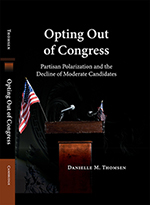Moderates Opt Out
February 9, 2018
Related:
From Maxwell Perspective...
Moderates Opt Out
Danielle Thomsen’s book explores how the current political climate discourages politicians with moderate views from seeking national office.
By Jeffrey Pepper Rodgers
 Danielle Thomsen
Danielle ThomsenWhen journalists and pundits talk about the bitter partisanship in Congress today, they tend to point to three culprits: gerrymandering, the influence of big money, and primary systems that favor more ideologically pure candidates. But when scholars have tested these hypotheses, according to Danielle Thomsen, assistant professor of political science, they have come up short.
“The most obvious counterpoint for the gerrymandering hypothesis is the Senate,” she says. “There’s been no change in district boundaries because they are state borders, but we’ve seen rising polarization.” In the case of big money, Thomsen adds, studies have found that public financing of campaigns has not resulted in the election of more moderates. The same goes for primaries — for instance, open and closed primaries, which are expected to generate different types of primary voters, have produced very similar types of candidates.
So what else could be behind today’s hyperpartisanship? In her new book, Opting Out of Congress: Partisan Polarization and the Decline of Moderate Candidates (Cambridge University Press), Thomsen argues that a crucial factor has been overlooked: who chooses to run in the first place. “Moderates who could run for Congress aren’t doing so to the same degree as conservative Republicans and liberal Democrats,” she says. “And if the only people who are signing up to run come from the extremes, polarization is unlikely to diminish.”
In her research, Thomsen initially focused on the partisan gap of women in Congress — to explore why the number of Republican women in Congress, most of whom were moderates, stagnated in the ’80s and ’90s while the cohort of women in the Democratic Party grew. But as she dug deeper, she found that the underlying issue of partisan polarization went beyond gender dynamics. The “hollowing out of the political center,” as she calls it in the book, applied equally to men and women in Congress.
Thomsen, who joined the faculty in 2015, notes that Congress has not always been like this. Forty years ago, moderates accounted for more than half of the House and had significant power. “Today,” she says, “with the moderate faction being perhaps 20 people, it’s very difficult to band together and shape the direction of the party.”
State governments are a different story. While some state legislatures are polarized, many are not. In Opting Out of Congress, Thomsen used data sets that became available in recent years to compare the ideology of state legislators with Congress members. She found that 20 percent of Republican state legislators and 30 percent of Democratic state legislators rank as moderate (judged in comparison with recently retired Congress members also deemed as moderate).
"If the only people who are signing up to run come from the extremes, polarization is unlikely to diminish."
Danielle Thomsen
The problem, Thomsen posits, is that moderates who are elected “have virtually no impact on policy, because the party leadership is setting the agenda and dictating the terms of debate. None of the top chair positions or the choice committee assignments are going to moderates. The moderates who are there are leaving, and they’re highly critical of the direction of their parties in Congress.”
What, if anything, can be done to create an environment where compromise — and progress — can be made? How do you get less extreme candidates to run? “Perhaps just as you do with any group that has been historically underrepresented — women, people of color — you put extra resources into them,” says Thomsen. “You recruit them. You give them institutional positions of power, such as a spot on Appropriations or Ways and Means. The party can incentivize certain behavior.” But right now, she admits, the odds don’t look good.
Photo Credit, photo of Danielle Thomsen: Steve Sartori, S.U. Photo & Imaging Center
This article appeared in the spring 2017 print edition of Maxwell Perspective; © 2017 Maxwell School of Syracuse University.
